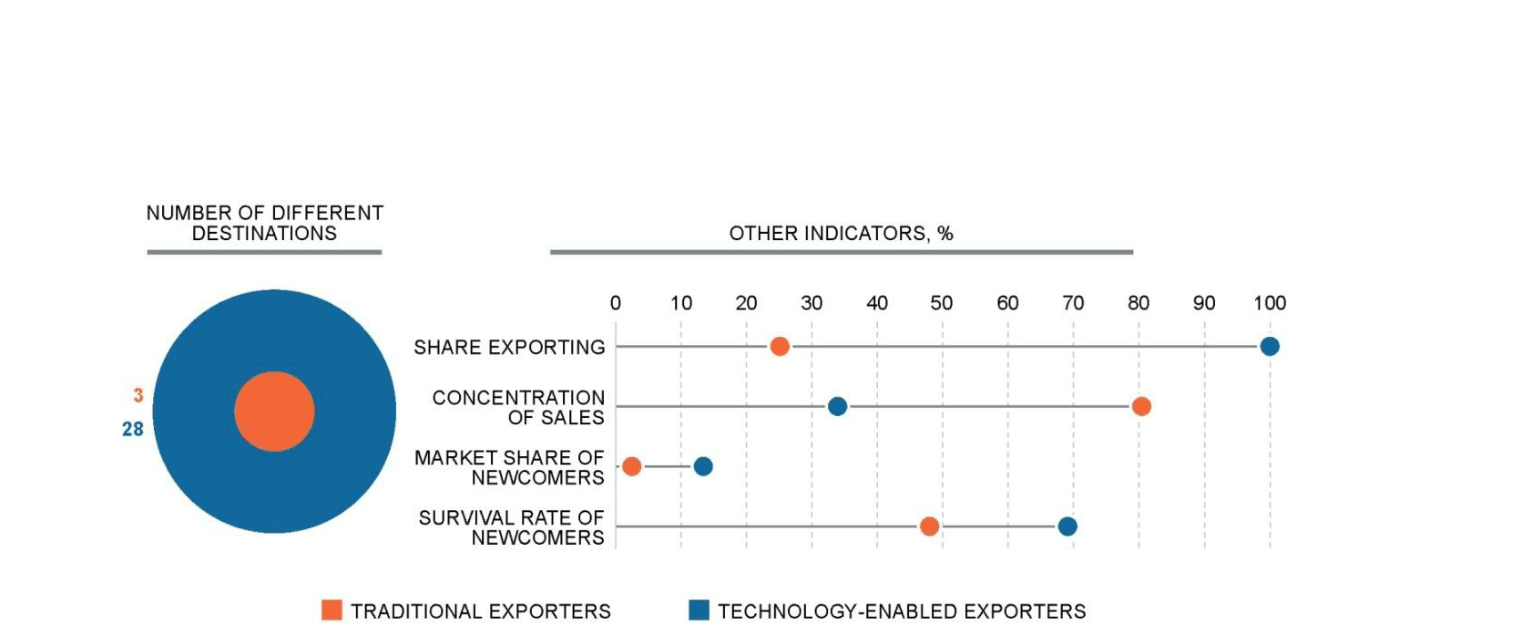In a nutshell
New tools of digital technology can facilitate cross-border e-commerce and participation in global markets for smaller and new entrants.
Technology-enabled firms are much more likely to export, to export to more destinations and to survive in the marketplace.
Policy in MENA countries needs to respond to these developments: by providing regulatory clarity, investing in digital literacy and entrepreneurship skills, identifying digital economy opportunities in export markets and improving payment systems.
Small and medium-sized enterprises (SMEs) are the backbone of Arab economies, accounting for 10-40% of their employment. But these figures are likely to be significantly under-reported in official records given that the typical country in the Middle East and North Africa (MENA) region employs 67% of its labour force informally.
MENA has 22 SMEs per 1,000 inhabitants, the highest density of any developing region. Yet in most countries in the region, SMEs are responsible for only a tiny share of the value of gross exports.
Participating in global value chains, which have become the dominant feature of world trade, provides opportunities for SMEs to enhance their integration into global markets for goods, services and investment. Such involvement can lower barriers to exporting by accommodating specialisation in narrow business functions, thereby obviating the need for a firm to develop a complex production process in-house and lessening its dependence on the degree of industrial development of the home country.
These aspects are especially important for SMEs, for which the best metaphor would not be a chain but a ladder. The disaggregation of production into separate stages allows SMEs not only to find their place on the ladder, but also to move up the rungs as their capabilities improve. Global value chains encourage that upward movement by rewarding skills, learning and innovation.
The relatively low weight of SMEs in exports at the total economy level partly reflects compositional effects and associated economies of scale. Exporting SMEs are significantly under-represented in (tangible) capital-intensive sectors, such as transport equipment. But they compare favourably in the services sector and in heterogeneous sectors where specialisation and branding can drive export penetration.
Firm size also affects the capacity to enter more distant and possibly more protected markets. In 2011, for example, SMEs in the European Union (EU) accounted for 37% of intra-EU exports but only 28% of extra-EU exports. Indeed, in most countries, SMEs typically export disproportionately more to neighbouring countries than do larger firms.
Our research points to signs that some SMEs are managing to internationalise by taking advantage of better access to digital technology, including the internet and mobile telecoms (Cusolito et al, 2016). The internet dramatically reduces the cost of finding buyers for SMEs, both domestically and globally.
Our research finds that technology-enabled firms are much more likely to export, to export to more destinations and to survive in the marketplace. Similarly, SMEs and new firms are likely to have a larger role in the export mix for technology-enabled trade than for traditional trade. Figure 1 makes this comparison for Jordan.
There is some evidence of the emergence of ‘micro-multinationals’ – small and young firms that are global from their inception. New digital tools can facilitate cross-border e-commerce and participation in global markets for smaller and new entrants – for example, Skype for communications, Google and Dropbox for file sharing, LinkedIn for finding talent, PayPal for transactions and eBay and Amazon for sales.
Evidence shows that an increasing number of producers in developing countries are selling using the internet, either through their own websites or through web portals such as eBay and Alibaba. Business-to-consumer e-commerce reached $1.5 trillion globally in 2014 and is growing at 25% per year, and even more rapidly in the MENA region (see Table 1). Business-to-business e-commerce may be even larger.
Much of this trade is export trade. By 2020, global online sales will amount to $10 trillion, with annual growth of 20% for business-to-consumer and 7.7% for business-to-business transactions. Much of that growth will originate in emerging markets, where the adoption of digital technology continues to rise rapidly.
Enhancing access to digital networks and enabling SMEs to engage in e-commerce can be an effective way for small MENA firms to go global and even grow across borders where they can become competitors in niche markets. But many potential gains could be lost without changes in the basic framework conditions facing MENA SMEs.
One important component concerns the regulatory burden. The administrative burden generated by governments for starting and running companies can be significant, but online government portals for information on business creation and registration can help lower the burden.
There are also barriers that limit competition that need to be addressed for economies to benefit fully from the internet. Regulatory and trade barriers persistently inhibit entrepreneurs from accessing domestic and foreign markets.
There are significant impediments to the ability of MENA SMEs to exploit the internet fully for exporting. While many have internet access, they either do not have websites through which they can do business, or they have limited understanding of how to leverage the internet as part of their business plan.
According to studies of Egypt, entrepreneurs also face systemic and cultural barriers to digital trade, which is an important enabler of participation in global value chains, particularly in the services sector. These barriers include:
- inadequate or costly telecoms infrastructure, including internet access;
- lack of digital literacy and skills, resulting in an unqualified labour force and uninformed consumers;
- unclear legal and regulatory systems and standards;
- difficulties with accessing electronic payment systems;
- complex and unreliable logistics and distribution networks;
- and lack of ‘one-stop-shop’ facilities to ease digital trade.
Access to larger markets and the possibility of specialising in tasks or stages of production (rather than building entire vertical supply chains) offers huge opportunities for smaller businesses and start-ups in MENA. Technology, notably the internet, is offering further opportunities for dynamic SMEs.
Policy needs to respond to these developments. But reducing existing barriers to digital trade and improving access to global markets will require a holistic approach to provide regulatory clarity, to invest in digital literacy and entrepreneurship skills, to identify digital economy opportunities in export markets and to improve payment systems.
Further reading
Cusolito, Ana Paula, Raed Safadi and Daria Taglioni (2016) Inclusive Global Value Chains: Policy Options for Small and Medium Enterprises and Low-Income Countries, Directions in Development: Trade, World Bank/OECD.
Figure 1: Jordan: performance of technology-enabled versus traditional exporters
Source: eBay 2014, 33.
Table 1: Global business-to-consumer e-commerce marketplace by region, 2012-17
(US$, billions; average annual growth, %)
| Region | 2012 | 2013 | 2014 | 2015 | 2016 | 2017 | CAGR (%) |
| Asia-Pacific | 301.2 | 383.9 | 525.2 | 681.2 | 855.7 | 1052.9 | 50 |
| North America | 379.5 | 461.0 | 482.6 | 538.3 | 597.9 | 660.4 | 15 |
| Western Europe | 277.5 | 312.0 | 347.4 | 382.7 | 414.2 | 445.0 | 12 |
| Central and Eastern Europe | 41.5 | 49.5 | 58.0 | 64.4 | 68.9 | 73.1 | 15 |
| Latin America | 37.6 | 48.1 | 57.7 | 64.9 | 70.6 | 74.6 | 20 |
| Middle East and Africa | 20.6 | 27.0 | 33.8 | 69.5 | 45.5 | 51.4 | 30 |
| Worldwide | 1,058 | 1,215 | 1,505 | 1,771 | 2,053 | 2,357 | 25 |
Source: eMarketer, cited in Suominen, 2014.
Note: CAGR = compound annual growth rate.


